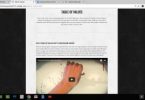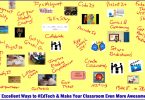While flipped learning is undoubtedly effective, we can also improve learning by flipping students’ mindsets
In 1970, I started using flipped learning for a Criminal Law course in community colleges. Then, in 1973, I won a million-dollar contract from the U.S. Army to develop multimedia lessons for their 1125 self-paced, mastery learning centers. Today I would call that flipped learning because the soldiers watched short lessons and then practiced to mastery in the classroom. These projects were wonderfully effective, as described in Parts 1 and 2 of this 5-part series of posts. In 1972, I had the opportunity to buy a small private 4th-12th grade school run by some people who already had ten or more years of experience with flipped learning. The entire school used flipped learning. Our success in helping students catch up and then keep up with their courses, allowed us to expand from 75 students in Corte Madera, California, to campuses in Palo Alto and Berkeley with a total enrollment of 450.
These learning successes turned me into a vocal advocate for flipped learning. I thought then that every teacher in every subject should switch to a flipped classroom. By 1985, I realized that most classes in most high schools and colleges were likely to continue to be lecture/discussion, with the students expected to “learn by doing” as homework. It seemed to me that there was a central problem in that conventional approach that led to poor outcomes for many students. The poor outcomes are still with us and include: high dropout rates in high schools and colleges, only 30% of the population getting college degrees, and many people being unprepared for the available, good jobs in a world of increasing automation and globalization.
I think the central problem is that almost everyone, including educators, students, parents, and politicians, thinks more about teaching than learning. They focus, for example, on how well teachers present instruction. Those of us in flipped learning know that it is more useful to focus on helping students to do the work of learning by practicing to mastery. There are, of course, educators who tell this to students. In colleges, especially those with open enrollment, deans often give this advice to an auditorium full of entering students: “We expect you to spend 2 hours outside of class studying, for every one hour in class. Look at the person to your right and the person on your left. Next fall, one of the three of you will no longer be here. Do your homework!” Unfortunately, that advice is rarely sufficient. In community colleges nationwide, only 1 in 5 entering students will either get a degree or go on to a four-year college. Four-year colleges do better, with about 55% of entering students earning degrees.
As I thought about conventional lecture/discussion courses in high school and college, it seemed that many students did well in them and liked them. It was also clear that the faculty and schools were reasonably happy and not very interested in changing that model. I thought maybe it would be possible to train students to do better in lecture/discussion courses. Here’s the story.
Student Success Courses
I started from the idea that school success starts with learning the subjects. Other skills, like test taking, help. But, it seems to me, that many students didn’t do the fundamentals: learn by doing, get help quickly, and persevere to mastery. So, I set these objectives.
After taking my Student Success course, students would regularly do these things in their other courses.
- Expect to learn primarily by practicing what you are learning to do.
- Prepare to practice by listening to lectures, watching videos, and reading books.
- Get help immediately while practicing, from friends, classmates, teachers, or a study group. Strike a balance between giving up too soon and struggling too long.
- Continue practicing to mastery, regardless of the time required.
Doing these four things take work. Even if students believed these steps would enable them to learn their subjects, would they do them? What were the incentives to motivate them after they left my class? Based on my experience, I made these assumptions about motivation. First, I assumed that every teenager and adult in the U.S. knew the value of education. In other words, no matter how they were doing in school and no matter they said about it, they wanted to be educated. Second, I knew that success is motivating. People like to do things they are good at. In addition, they like to get better at things they can already do to some extent. So, I decided the real barrier to motivating students was not the work involved, but lack of confidence and uncertainty. People are sensibly hesitant to try something new. They also balk to do the work if they don’t think they can succeed.
These assumptions led us to design a course in which students would have success with a series of learning assignments of increasing difficulty. They would also experience that overall, they could excel in school with less work than it took to just get by. Finally, they would experience getting smarter. By definition, a person’s IQ can’t go up. But that’s a problem with the definition of IQ. People who graduate high school able to do algebra, calculus, speak a new language and write good essays are smarter than people who can’t.
My First Attempt
To try out these ideas, I put an ad in the local newspaper in the summer of 1985: “High school and college students wanted to test a Student Success course. Monday to Friday, 9 a.m. to 1 p.m., for three weeks.” I hired 15 students.
The results were amazing. One 13-year-old said, “It isn’t that I thought I was stupid, but I feel like my brain woke up.” A girl who had just graduated from high school said, “I expected that I would start College of Marin in the fall, flunk out around Thanksgiving, and start the new year cleaning rooms at a local motel. Now I realize that I have to learn some things before I’ll be ready for college courses. I called the college yesterday afternoon. They told me I can take remedial writing and math and that in about a year I’ll be ready for college. I’m a good reader and I have an interest in Psychology, so I’ve decided I can handle that one regular course along with the makeup work.”
One of the boys in the group came to class one day wearing a sports jacket, slacks and a tie. He told the class, “I see now how I can do a lot better in school. So, I decided to come today dressed as the smartest guy on the bus rather than the dumbest.”
How About Pubic Speaking?
Over that winter, I worked with a small team to refine this flipped learning Student Success course to achieve the outcomes listed above. To put a bow on the package, I wanted a big experience as the centerpiece of the course.
At that time, various experiential programs were popular. Some of those were directed at students’ self-esteem and self-confidence, which was definitely of interest to us. Most of these programs were focused on non-academic skills, like white-water rafting, mountain climbing, or wilderness survival. However, it seems to me that, for many people, there is not much transfer of self-confidence from one activity to another.
Then, my personal difficulty with shyness gave me an idea. As a student, I was terrified to speak in public. This stayed with me through my PhD and into my career as a rocket scientist. I was accomplished and bright, but I was anguished in front of an audience. I felt sick for days before speaking engagements and avoided them when I could. At age 35, I had a breakthrough from a short series of public speaking exercises in a self-actualization course I took.
I thought that public speaking could be a perfect centerpiece for our Student Success course. It is a skill that most people consider an inherent talent—some have it and most don’t. Second, it is valuable in school as well as everywhere else in life. I had some confidence that public speaking could be learned by practicing to mastery, one gradual step at a time. Finally, public speaking is observable. If everyone in a class got better, everyone else would see that. I figured that, if students saw themselves and everyone else getting better at something impossible like public speaking, then, surely, they could learn easy stuff like algebra and a foreign language.
Flipped Learning Student Success Course
We ran 3 sessions of our new course in the summer of 1986 for a total of 77 students. The following year, we trained over 100 teachers and delivered the program to 1655 students at CalPoly, San Luis Obispo, CA. The next year we promoted some teachers to site directors and began delivering the program in 8 locations simultaneously. The 1988 enrollment was 3550 students. I think we have demonstrated that the course is scalable and not dependent upon the personality or talents of anyone special.
Results
Almost 300 teachers and professors have now delivered this course to 9000 students. In a survey six months after our summer programs on college campuses in California, 93% of 1029 students reported improvements in three or more outcomes like grades, time management, motivation, and academic confidence.
The payoff from a successful Student Success Course is enormous. An entering high school or college student is going to take 30 semester-long courses over 4 years. If Student Success courses are effective, student outcomes in 30 to 60 conventional courses will improve, without having to expand the effort, time and money to flip all those courses.
I think our Student Success course works because the students practice learning various things, including public speaking, by practicing to mastery. They do this in a flipped classroom where the instructor can give individual coaching and feedback. They do sufficient practice in learning by doing, getting help as needed, and persevering to mastery to experience that it works for them.
Flipping Courses or Students?
From my experiences, I am clear that flipped learning can improve student outcomes enormously. I am also certain that a flipped Student Success course that takes about 50 hours can prepare students to excel in regular, un-flipped classes.
So, which is better? I think it depends upon your situation. If you are responsible for teaching courses in your field and fewer than 75% of your students are mastering your courses, you should flip your courses. If you are a Student Success professor or instructor, then you, too, should flip your course to prepare your students to master their other lecture/discussion courses.
More Information
If you are interested in more details about the course, you can view our text/workbook Power Learners Handbook for College Success and the accompanying Instructor’s Guide on the Internet.
Power Learners Handbook – College
Instructor’s Guide – College
We also have high school editions of these books.
In the next and final post in this series, I will share what I consider the most successful and inspiring example of flipped learning. I think it suggests the extraordinary outcomes we can achieve with flipped learning.




